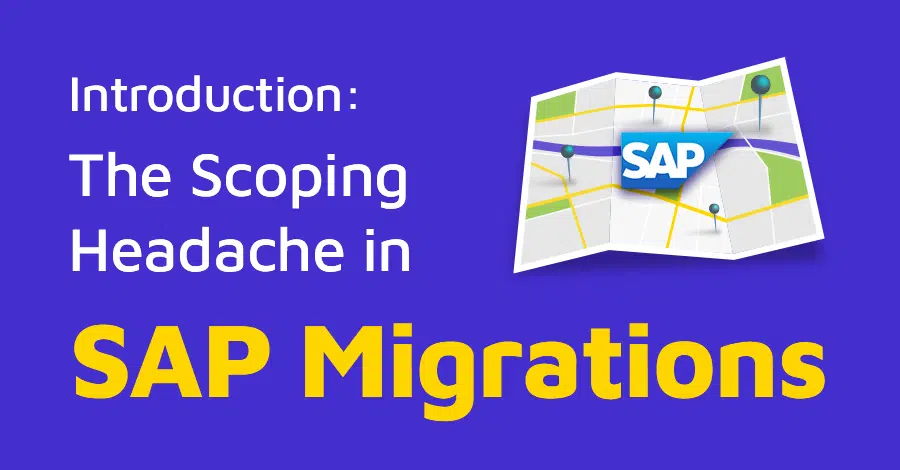Table of Content
Introduction: The Scoping Headache in SAP Migrations
Scoping an SAP S/4HANA migration project often feels like trying to capture water with your hands – no matter how careful you are, there’s always something slipping through. For most IT leaders and System Integrators, this process is a pain point that adds weeks or months to timelines, with countless hours spent interviewing key users, mapping out complex business processes, identifying custom code dependencies, and ultimately creating a compelling business case (or pricing an RFP bid). And even with all this effort, the result often leaves room for unexpected issues.

SAP S/4HANA migration projects are long and complex, taking 2-3 years (depending on the scope, migration route and custom code, and overall complexity), high-level project plan and typical timeline.
If this sounds familiar, you’re not alone. We’ve seen this struggle repeated across organizations. Traditional scoping methods are labor-intensive and don’t guarantee accuracy, making it challenging to create a solid project roadmap.
The True Scope of a Migration Project: How Accurate Assessment Saves Time and Money
SAP S/4HANA migration projects often involve intricate dependency mapping, custom code assessments, and time-consuming user interviews. A common pain point we hear is how many weeks are spent in manual, repetitive work trying to capture the full scope. Key users, familiar with business processes, need to be interviewed in depth, and that process can still leave critical details about code dependencies and testing requirements unaddressed.
Imagine scoping your entire migration project in under 48 hours. No guesswork, no manual hunting for dependencies, and no overlooked code adjustments. With Panaya’s ACC and S/4HANA migration assessment tools, you can conduct a deep, accurate analysis of your SAP environment in a fraction of the time. This efficiency doesn’t just reduce manual effort; it allows you to receive a tailored plan for your migration that includes specific code corrections based on SAP best practices.
Mapping the Path: How Panaya’s S/4HANA Migration Assessment Works
An accurate assessment isn’t just about identifying tasks; it’s about creating a migration roadmap that captures every relevant detail, from dependencies to testing steps. Here’s how Panaya makes it easy:
Panaya’s platform runs a deep analysis of the system objects and custom developments and automatically maps dependencies within your SAP ecosystem, revealing how different modules and custom code interact. This precision not only ensures nothing is missed but also provides clarity on which components require attention, sparing you from the unexpected costs and delays of last-minute discoveries.

Mapping the ocean floors can be done manually with highly qualified scuba divers and expensive equipment or can be done using sonar extremely accurately and with considerably less effort. (https://lakeerieliving.com/articles/2022-mayjune/charting-waters-mapping-lake-erie/)
Unlike traditional scoping methods, which rely on manual discovery and user interviews, Panaya’s solution offers a complete and comprehensive view of your SAP environment, including compatibility analysis, prioritized code corrections, and automatic proposed fixes for ATC findings.
Creating a Business Case That Drives Project Approval
Gaining buy-in from stakeholders requires more than enthusiasm; it demands a clear, data-backed business case that shows the ROI and feasibility of the project. Panaya’s Platform doesn’t just help you understand the scope, it provides the data needed to build a compelling business case:
Panaya delivers a tailored project plan, including quantifiable data on everything from code fixes to testing requirements, which helps you set clear timelines, budgets, and resource needs. Panaya’s detailed reports go beyond surface-level recommendations, giving you the insights to propose realistic, achievable plans to decision-makers. This data-driven foundation not only supports project approval but also reduces the risk of scope expansion and cost overruns once the project begins.
From Planning to Execution: Achieving a Seamless Migration with Panaya
A well-scoped project sets the stage, but a well-executed project ensures success. Panaya’s Platform takes you from theory to practice, supporting seamless execution with features tailored to each phase:
Automatic Code Correction (ACC): Code changes introduce risk, especially in highly customized SAP environments. Panaya’s ACC automates the correction process, saving your team from time-consuming manual fixes. Panaya’s platform identifies and suggests solutions for code incompatibilities, minimizing disruption and ensuring stability throughout the migration.
By integrating testing activities into the initial scope, Panaya’s tools ensure that testing is an embedded, continuous process rather than a last-minute scramble. This approach enables a smooth transition to S/4HANA without sacrificing productivity or system uptime.
Panaya’s Platform ultimately empowers IT and business teams to collaborate, stay on top of potential issues with real-time validation, and monitor changes before they become obstacles.
Conclusion: Don’t Leave Your Project Scope to Chance
In the complex world of SAP migrations, a well-defined project scope is your greatest asset. Avoiding surprises requires a thorough, technology-driven approach that takes the guesswork out of scoping. With Panaya’s ACC and 48-hour assessment, you’re not only prepared for a successful migration – you’re equipped to build a clear, data-backed business case that earns buy-in from all stakeholders.
Take the first step toward a smooth, disruption-free S/4HANA migration. Explore how Panaya can help you scope your SAP project effectively and bring predictability to your migration process.
